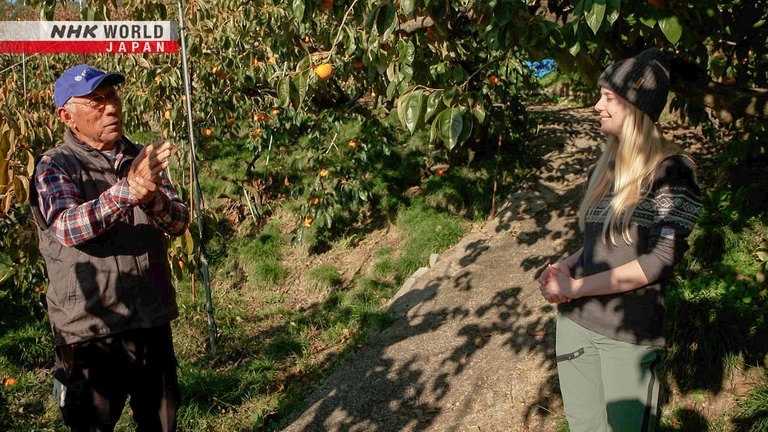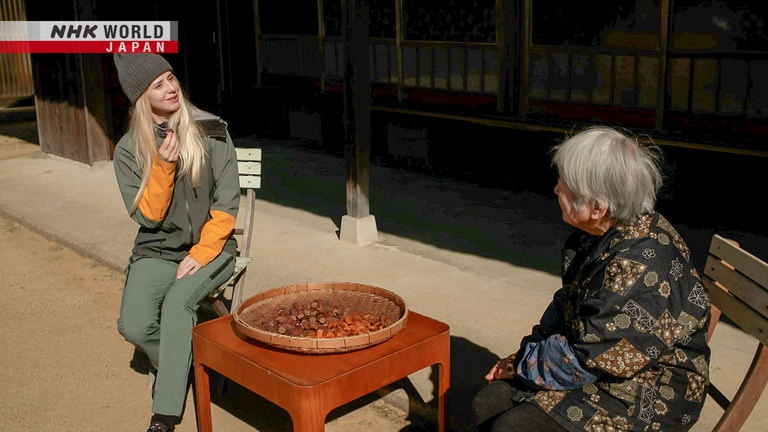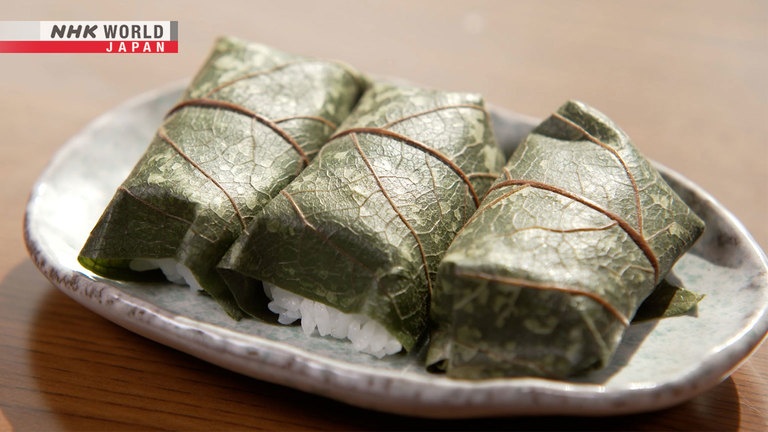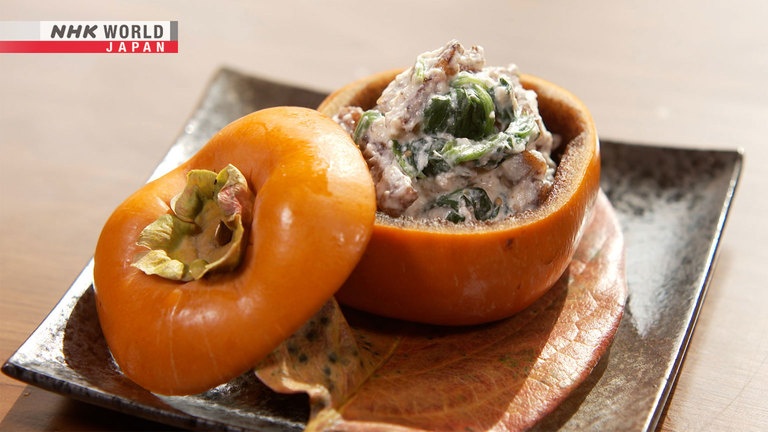KAKI
Kaki, or Japanese persimmons, represent fall in Japan. Introduced to Europe in around the 16th century, the fruit is referred to by its Japanese name around the world. Around 60 varieties of nutritious kaki can be found across Japan, with differing flavors and shapes. Visit Wakayama Prefecture to taste local kaki dishes, then head to a village deep in the mountains where curtains of dried kaki hang. Discover a New Year's tradition involving the fruit, and more about kaki's deep roots in Japanese culture. (Reporter: Janni Olsson)




Transcript
Tokyo: this world-class metropolis is a veritable gourmet wonderland.
Discover the stories behind the ingredients that make this city so delicious - so "oishii."
Kaki, or Japanese persimmons, represent the fall season in Japan.
They're best after turning a vivid orange color.
Very sweet.
They're packed with energy.
One kaki offers enough vitamin C for the day.
Since long ago, sun-dried kaki have provided nutrition during harsh winters.
Introduced to Europe through trade in the 16th century, today, kaki are referred to by their Japanese name in many countries around the world.
Unravel the tasty secrets behind kaki, Japan's global star.
Trails to Oishii Tokyo.
Hello, everyone.
My name is Janni Olson, and the theme of today's show is kaki.
So, I didn't know about this ingredient until I came here to Japan, but for Japanese people, it symbolizes autumn.
Let's find out some more. Come on!
Janni, from Sweden, is at the produce section of Tokyo's Toyosu Market.
It's one of the world's largest wholesale markets, offering a variety of produce from across Japan.
She visits a wholesaler that's been around for over 100 years.
- Hi. I'm Janni.
- I'm Maki. Thanks for coming.
Maki Masahiro is a 30-year veteran, and a kaki expert.
Are these all kaki?
These here, and there.
Janni finds kaki of various shapes: square, round, and even pointed ones.
- This is a lot.
- It is.
They have different textures.
Some are crunchy, some are even gooey.
Interesting. I had no idea.
Maki has something special to show her.
Does this remind you of anything?
...a mountain?
It's pointed.
Japan's famous mountain is...?
- Mt. Fuji!
- Right.
This is called Fuji kaki.
How cool.
Kaki likely came to Japan from China in the 8th century, after which breeding expanded.
An encyclopedia of herbal medicine from the Edo period details many types of kaki.
There are now over 60 varieties grown in Japan.
Time to try some.
"Itadakimasu."
A subtle sweetness.
- Nice and light.
- Exactly.
Not like citrus fruit.
"Oishii."
The variety that Janni ate is naturally bitter.
Most kaki in Japan are that way, and can't be eaten straight from the tree.
After harvest, alcohol or carbon dioxide are used to remove bitterness and bring out the fruits' sweetness.
Only then are they ready to be eaten.
These to the right are the same variety, but of a higher grade mainly for gifts.
So, what's the difference?
Let's cut into it.
Wow! - Wait, is this a different variety?
- The same.
Dark meat!
The answer lies in when the bitterness is removed.
Before harvest, they are placed in bags containing alcohol.
This causes bitter compounds to harden and turn a dark color as the fruit sweetens during the ripening process.
The dark part has bitter compounds,
but it's firm now, so it won't taste that way.
How interesting.
Same variety, different color.
It's sweet.
What's the best region for kaki?
If I had to choose one, I'd say Wakayama.
I'll have to go there.
Thank you very much!
You're welcome.
A four-hour trip by plane and car takes Janni to Wakayama, Japan's largest producer of kaki.
Her destination is Katsuragi in the northeastern part of the prefecture.
Nature-rich Katsuragi is surrounded by mountains from north to south, with the Kino River flowing through the center.
The temperate climate year-round is ideal for growing kaki.
Hello!
- May I?
- Be my guest.
Come on!
Nice to meet you. I'm Janni.
I'm Yamada. Welcome.
Kasturagi native Yamada Yoshihiko has been growing kaki for over 40 years.
Yamada's farm faces west, giving kaki the long hours of sunlight they need to grow extra tasty.
The trees sit quite low.
Is that common?
We keep them that way
to make our work easier.
- It's intentional?
- Yes.
I see. Very easy to reach.
Upward-growing branches are trimmed to make the trees grow wider and at a reachable height.
Going deeper into the orchard, they find harvest-ready kaki.
Japan's most common variety is the "fuyu kaki."
It's naturally sweet and doesn't need to be debittered.
Janni will learn how to cut off kaki.
Kaki hang from branches on small stems.
They are cut carefully at the base of the stem to avoid damaging the fruit.
He has just the right tool for the job.
They're curved scissors with dull tips.
It's Janni's turn.
Yay!
How do I know which ones to cut?
The color.
This one is vivid orange.
- This one is lighter.
- I see that.
Darker is tastier.
Got it.
These are ready.
Okay.
Go for it.
- Easy-peasy.
- That's it?
In the fall, temperature gaps between night and day enhance the kaki's flavor.
They become sweeter as they store nutrients to withstand colder temperatures.
Even on the same tree, kaki change color at different speeds depending on how much sun they get, so they need to be checked closely before cutting.
They don't turn the right color in the shade.
See here?
The leaf was covering it like this.
Parts shaded by leaves have delayed coloration.
Thinning out leaves will ensure even sun exposure.
But if we pick leaves too early,
the kaki will get too much sun.
Ah, I see.
Too much right away is bad for them.
You have to go easy on them?
That's tricky.
Kaki flowers bloom around May, and each one is pollinated by hand.
Farmers reduce the number of fruits to two or three per branch.
That gives them room to grow larger and store more nutrients.
The fruits of their labor?
Tasty kaki come harvest time.
Careful pruning will result in a good harvest.
You'll know if you didn't do it right.
The quality reflects a year's work.
When I see good kaki, I know
that all the hard work has paid off.
Very nice.
Yamada finds one that's grown big and orange over the last six months.
Very orange.
Sweet! Very sweet.
Great to hear.
Every fall, Yamada hand-picks over 30,000 fuyu kaki.
Yamada will work alongside mother nature until early December.
You can eat kaki like any other fruit, but it's proven itself to be great for cooking as well.
Kaki dishes await Janni at another farmer's house.
- Hello.
- Welcome.
Yamamoto Takemi is a local kaki farmer.
She'll whip up something special for Janni.
Here you are.
Looks lovely.
Kaki and spinach mixed in tofu dressing, with kaki as the vessel.
The dressing is a traditional recipe including tofu, miso paste, and sesame.
Sweet kaki and spinach are the main ingredients.
The kaki's sweetness and texture add an elegant flare to the mild tofu.
- "Oishii!"
- Great!
I wasn't sure about spinach with fruit.
It's a great side dish.
Next up is deep-fried kaki.
Kaki become sweeter when cooked, and spring rolls are a great way to enjoy that.
Inside are kaki, boiled asparagus, and cheese.
- How is it?
- Yummy.
Good!
The sweet kaki, creamy cheese,
and crispy wrapper work well together.
The asparagus keeps it light too.
Very tasty.
With kaki, nothing goes to waste - the leaves are also used.
This dish is unique to kaki producing areas.
Sushi rice and mackerel marinated in salted vinegar are wrapped to create a kaki leaf sushi roll.
Dating back to the Edo period, the preserved food makes use of the leaves' antibacterial properties.
The aroma they provide is an added bonus.
I hope you're hungry.
Now for Yamamoto's favorite dessert - dried kaki mixed with "kinako" soybean powder, a common ingredient in traditional sweets.
No sugar is used - the kaki provides all the sweetness.
This is dessert.
This looks very Japanese to me.
- This is kaki too?
- Of course!
- Sweet, right?
- It is.
Kaki is good no matter how you eat it.
It's easy to use.
The leaves for sushi, the fruit for cooking.
It may not be obvious,
but kaki is pretty versatile.
It's a unique ingredient.
Locally-sourced kaki adorns the dinner table with an array of dishes using all parts of the fruit.
Janni heads to a village deep in the mountains in northwestern Katsuragi.
Dried kaki is a long-standing tradition here.
Okay, so I think these are kaki as well, but dried ones?
Curtains of kaki glisten in the sun.
Janni is curious to find out more.
Hello.
- I'm Janni. Nice to meet you.
- Hello and welcome.
Matoba Yaeko has lived in the village for over 50 years.
I saw hanging kaki as I walked in.
What is that for?
We call it "kushi kaki."
It's to celebrate New Year's,
to pray for a happy family.
I see.
Not to eat, but for decoration?
Right.
I have pictures.
These are family photos from New Year's.
How nice.
Rice cakes are offered at New Year's to pray for family prosperity.
In West Japan, dried kaki are often placed on top of rice cakes.
Kushi kaki have been made in Shigo for over 400 years.
Currently, the area is the main producer of the traditional decoration.
I'll take one down.
There's more to it than just drying.
Matoba will take Janni through the process.
It's pretty heavy.
- You press them?
- Yes.
- Wow.
- This is the first step.
Press the meat first, then the stem.
The two-step process is done carefully to avoid cracking the fruit.
The fruits are flattened gradually over several days until a powder forms on the surface.
- It's tough work!
- It is.
We do this every day.
- I thought you just hang them.
- No.
They need constant care, like children.
We have to press them every day.
The cool mountain breeze and direct sunlight create the perfect environment for kushi kaki.
In fall, they paint the village in orange.
Matoba also makes dried kaki for daily use.
We snack on them all year.
Janni will learn how they're dried.
I'll try to make a nice one!
Back when sugar was still a luxury in Japan, fruit was the star of the show.
Dried kaki are a perfect example.
Sun-drying them naturally reduces bitterness.
And as they release moisture, the pulp condenses and releases sweetness.
Drying kaki makes it three to four times sweeter than when it's fresh.
Kaki is like sunshine.
It gives you strength.
Yes. It's a source of energy.
Something to be thankful for.
Far from Tokyo, Janni enjoys dried kaki surrounded by nature.
This is really special, sitting here
and eating homemade dried kaki.
It's a lovely experience.
So nice.
In Shigo, the spirit of fall lies in kaki and the passion of villagers.
We are back in Tokyo, and there's a restaurant in the area where we can try dishes with kaki in them.
Let's go.
Janni heads to an Italian restaurant in a residential part of west Tokyo.
Hello. I'm Janni.
Thanks for coming.
Chef Hirose incorporates seasonal fruits into his Italian recipes.
In fall, he turns to kaki.
He uses a variety called "taishu kaki," characterized by a crispy texture and high juice content.
First, an appetizer.
He arranges kaki pieces over arugula, a leafy green.
He tops it with Stracciatella, a soft Italian cheese.
Sweet kaki and light, milky cheese seasoned with salt, pepper and olive oil.
Here you are.
Kaki and Stracciatella cheese.
Cheese and kaki?
- Very good.
- Thank you very much.
Soft cheese with sweet, crispy kaki.
A nice combo. Great texture.
The main dish is meat.
This is soppressata, an Italian dry salami containing pork cheek, ears, feet, and tongue.
And a kaki sauce: sweet kaki is combined with pungent onions and peppers, and tart wine vinegar.
Olive oil is drizzled on top.
Enjoy.
- You use kaki to make sauce?
- Right. It's a versatile fruit.
I learned something.
It really spreads like a sauce.
Here we go.
Excellent!
Thank you.
I often eat Italian food in Sweden,
but this is very new to me. How fun.
Hirose also uses kaki in pizza.
He spreads mascarpone cream cheese and whipped cream over pizza dough and pops it into a wood-fired oven.
This is topped with a generous amount of yogurt cream and fresh, sweet kaki.
Honey is drizzled on top.
An original recipe only available in fall - kaki season.
Dessert pizza?
Okay. Dessert pizza. Here we go.
- "Oishii."
- Thanks! Glad you like it.
Is kaki easy to use?
I sure think so.
It has a way of coexisting with other ingredients.
It's a fruit that goes beyond dessert recipes.
That makes them superior.
The sky's the limit. It'll pop up in more recipes.
It'll be exciting to see what people come up with.
Not your ordinary fruit, kaki can be used in a variety of ways.
The gift of fall supported the lives of people in the areas it grew.
And today, the kaki continues to reveal its hidden charms.
In Tokyo, every ingredient has its own story.